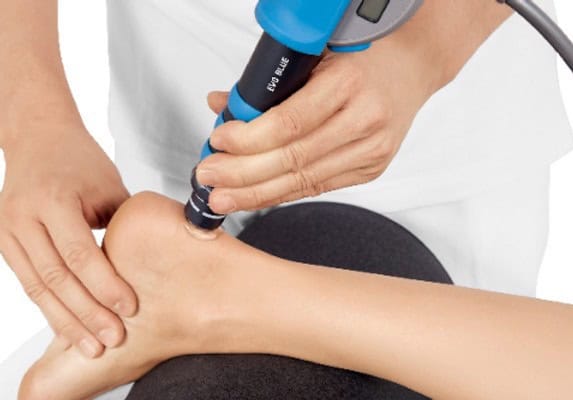Have you ever been to a physiotherapy clinic and felt like you heard some sort of loud construction equipment down the hall or in the room over? Although that may have been the case, often times it is shockwave therapy that you are hearing!
How does shockwave therapy work?
Shockwave therapy is a non-invasive treatment that uses a handheld device to deliver mechanical pressure to an injured area. We won’t get into the physics of shockwave therapy, however you can expect your therapist to be holding a shockwave device against an injured area for the duration of the treatment. With the device sending high energy soundwaves into the injured area, this will stimulate an increase in blood flow to the area, increase growth hormones to the area and promote an increase in new tissue growth. This will ultimately help to reduce pain, improve circulation and healing of the damaged tissue.

What injuries can shockwave therapy treat?
- Shoulder pain: rotator cuff tendinopathy, long head of biceps injuries
- Elbow pain: lateral epicondylitis (tennis elbow), medial epicondylitis (golfers’ elbow)
- Hip pain: gluteal tendinopathies
- Knee pain: patellar tendinopathy, quadriceps tendinopathy, hamstring injuries
- Ankle pain: Achilles tendinopathy
- Foot pain: plantar fasciitis
What is the evidence regarding shockwave therapy?
Research surrounding the use of shockwave therapy is still growing. Some evidence has shown that a combination of shockwave therapy and passive stretching for plantar fascia was more effective in reducing symptoms than stretching or shockwave alone. Another research article looked at the effectiveness of shockwave therapy on calcaneal spurs and pain. All patients underwent shockwave once a week for 5 weeks. It was shown that approximately 67% of patients reported no pain after the study. However, it was reported there was no correlation between clinical outcome and radiologic changes.
Is shockwave therapy painful?
If you know of someone who has had shockwave therapy, they have likely mentioned it is not the most comfortable thing they have experienced. During the therapy, the shockwave will be delivered to the injured area (tendon etc.), in which there may be some discomfort. This will depend on the injury, the individual as well as the settings of the shockwave machine. Typically, it should be at an intensity where you can feel the shockwave pulses, however it is tolerable enough to last the entire session. Occasionally, there may be some discomfort after the therapy is done, however this will subside within 24 hours.
What are some benefits of shockwave therapy?
1.Reduces pain: many patients have a reduction in their pain intensity after treatment, making shockwave a beneficial option to reduce pain instead of using pain medications
2.Non-invasive: this treatment is non-invasive, meaning it does not require incisions or surgery
3.Improved mobility and activity: many patients report having improved function after sessions of shockwave therapy. This translates into helping them get back to activities they want to get back to.
4.A quick treatment option: A shockwave therapy session takes as little as approximately 5-10 minutes

How many sessions of shockwave therapy are needed?
The short answer is – it depends! The number of shockwave session can vary depending on multiple factors such as the type of injury, the severity of the injury, duration of dealing with the injury (i.e. acute vs. chronic), the age and the overall health of the individual. Typically, most individuals will require anywhere from 3 to 6 sessions of shockwave before they see a significant improvement in their condition. With that being said, some individuals will see large improvements in their pain within the first few sessions, however for the entire benefits of shockwave the occur, the total duration of treatment is approximately 12 weeks.
Can shockwave therapy be used as an additive to other treatment techniques?
Yes, shockwave therapy should in fact only be one part of your treatment experience. Depending on your injury and assessment findings, your healthcare provider (i.e. physiotherapist) will recommend multiple treatment options to help you reduce your pain and regain function. For example, your physiotherapist will likely include treatments of soft-tissue techniques, mobilizations, passive stretching, acupuncture and prescribe you a personalized exercise program to improve mobility, flexibility, and strength. In a study assessing the management of Achilles tendinopathy, they studied the use of shockwave therapy and exercises to exercises alone. It was found that the combination of shockwave therapy and exercises was superior to exercises alone at a 4 month follow up.
Shockwave therapy is beneficial for many types of conditions and impairments. If you are suffering in pain from an injury and are wanting to feel better and return to the activities you enjoy, ask one of our therapists if shockwave may benefit you!
